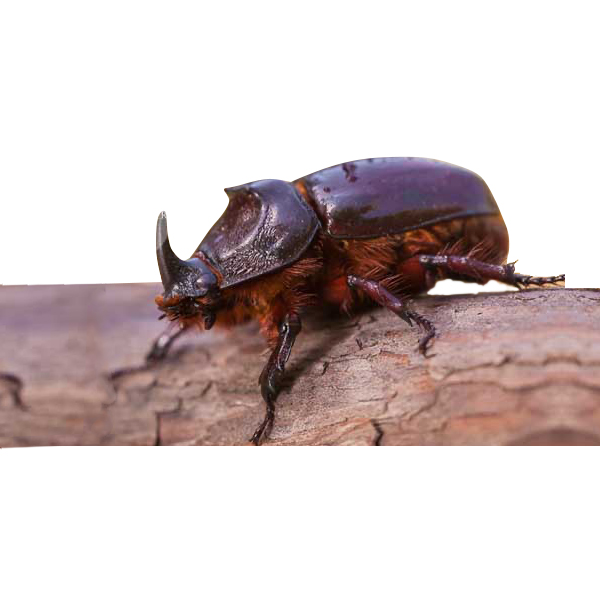Biology
The coconut rhinoceros beetle is one of the most damaging insects to coconut palms and African oil palm in southern and south- east Asia and the Western Pacific islands. The imagos are the destructive stage, they bore into the crown of the palm resulting in wedge shaped or “V” cuts in the fronds that unfurl. The beetle feeds on tissue juices. Some of the crushed fibre is pushed outside the entrance hole, where it indicates the insect’s presence. In India damage of inflorescence is also reported in severely infested areas which cause reduction in yield up to 10% (Nair, 1986). Ramachandran et al. (1963) has reported a loss in yield of 5.5 to 9.1% due to beetle attack. From artificially pruned leaf damage stimulation studies it was observed that damage to 50% fronds corresponds to leaf area reduction of 13% and decrease in nut yield by 23% (Young, 1974).
In oil palm O. rhinoceros bores into the base of cluster of spears, causing wedge shaped cuts in the unfolded fronds. In younger palms the effect of damage can be much more severe (Wood, 1968; 1976). Attack by adults may reduce yield and kill seedlings. They may provide entry points for lethal secondary attacks by the palm weevil Rhyncophorus or by other pathogens, in some countries (Bedford, 1980). Apart from coconut and African oil palm recorded host plants include the date palm and a variety of palms grown for ornamental purpose, including Roystonea regia, Livistona chinensis, Corypha umbraculifera and Raphia ruffia (Gressitt, 1953; Bedford,1980); also recorded are pine apple, sugarcane, pandanus and banana (Lever, 1979) (Source: Global Invasive Species Database, 2005).
Nature of Damage
The coconut rhinoceros beetle is one of the most damaging insects to coconut palms and African oil palm in southern and south- east Asia and the Western Pacific islands. The imagos are the destructive stage, they bore into the crown of the palm resulting in wedge shaped or “V” cuts in the fronds that unfurl. The beetle feeds on tissue juices. Some of the crushed fibre is pushed outside the entrance hole, where it indicates the insect’s presence. In India damage of inflorescence is also reported in severely infested areas which cause reduction in yield up to 10% (Nair, 1986). Ramachandran et al. (1963) has reported a loss in yield of 5.5 to 9.1% due to beetle attack. From artificially pruned leaf damage stimulation studies it was observed that damage to 50% fronds corresponds to leaf area reduction of 13% and decrease in nut yield by 23% (Young, 1974).
In oil palm O. rhinoceros bores into the base of cluster of spears, causing wedge shaped cuts in the unfolded fronds. In younger palms the effect of damage can be much more severe (Wood, 1968; 1976). Attack by adults may reduce yield and kill seedlings. They may provide entry points for lethal secondary attacks by the palm weevil Rhyncophorus or by other pathogens, in some countries (Bedford, 1980). Apart from coconut and African oil palm recorded host plants include the date palm and a variety of palms grown for ornamental purpose, including Roystonea regia, Livistona chinensis, Corypha umbraculifera and Raphia ruffia (Gressitt, 1953; Bedford,1980); also recorded are pine apple, sugarcane, pandanus and banana (Lever, 1979) (Source: Global Invasive Species Database, 2005).


